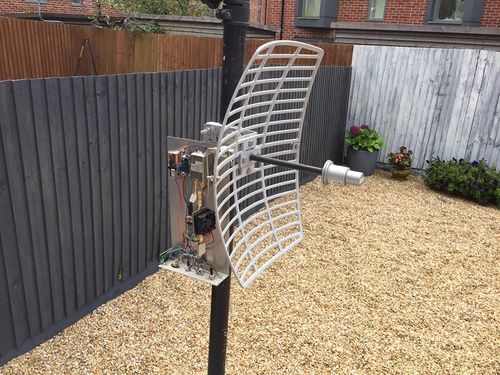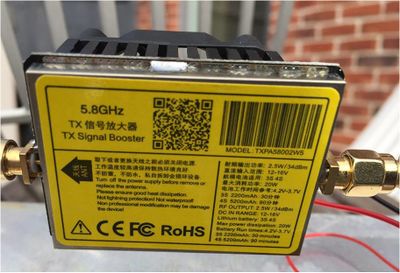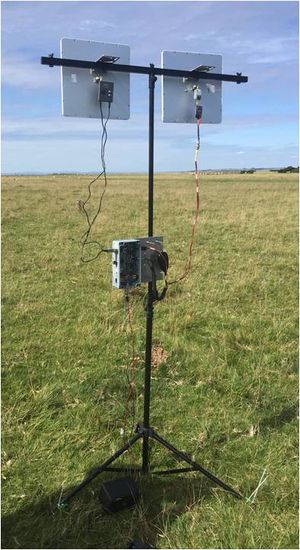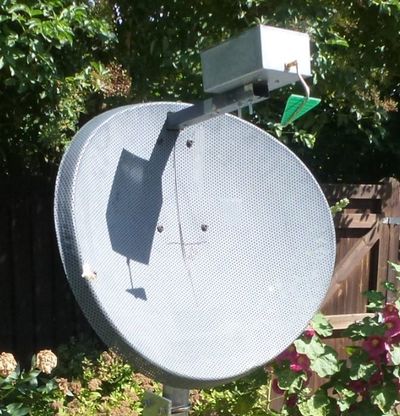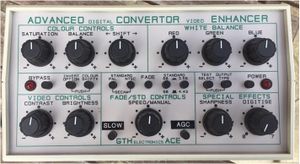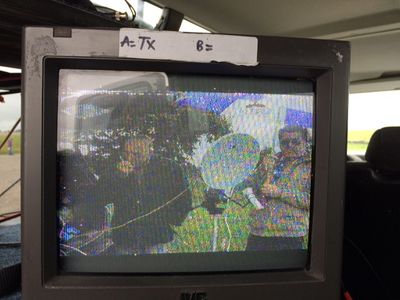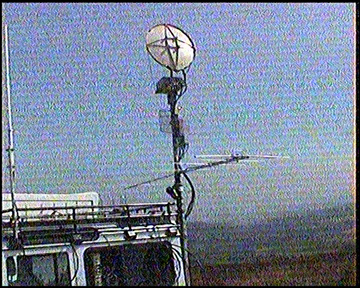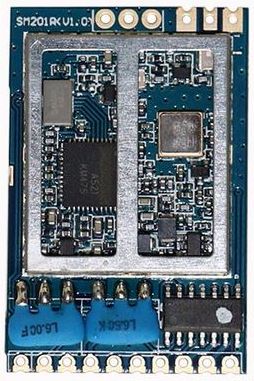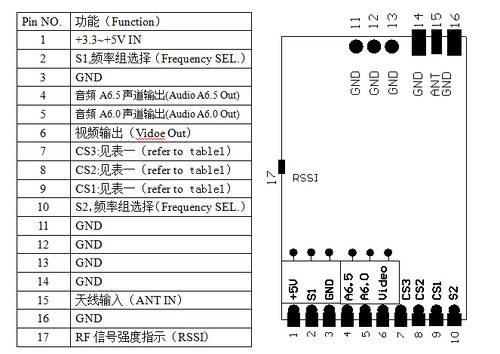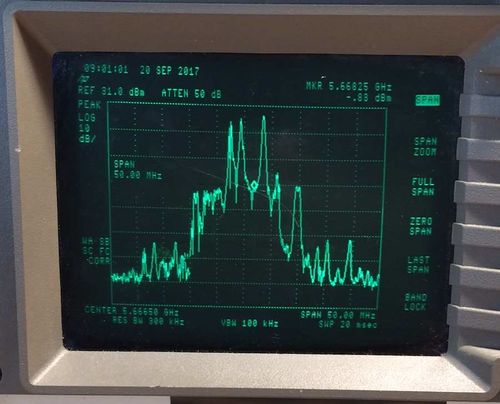5.6 GHz
It is very easy (and low cost) to get on the air on 5.6GHz (the 6 cm amateur band) using the cheap modules intended to transmit “First Person Video” (FPV) back from drones to their operators.
These units can be used without any modifications to get on air, and with a simple wifi plate or dish antennae and a clear line of sight path, can be used to can send pictures to stations using the same equipment over 50 Kms away.
Frequency choice
The UK amateur band plan is shown on the RSGB website here: https://thersgb.org/services/bandplans/html/rsgb_band_plan_2017.htm
GB3KM has a licenced input on 5665 MHz and this has been chosen as the primary ATV operating frequency.
The FPV equipment receive and transmit frequencies are set using DIP switches, and most tune to this frequency but care needs to be taken when selecting equipment to make sure it does cover this frequency. Example channel tables are shown at the bottom of this page.
Equipment
The FPV units are widely advertised on eBay and other sites with titles similar to “Tarot 5.8G 600MW Telemetry TX/RX Combo for FPV Image Transmission TL300N” and are available at reasonable prices. The typical units are very small but have reasonable FM-TV performance with a quoted spec of 600 milliwatts out and receiver sensitivity of -80 dBm. Amplifiers are available to raise the output power to 2 watts or more.
Be aware - we have found that on some rx units, the video out is on the Red phono lead and not the expected Yellow lead!
Mounting the equipment
Due to the very high losses in co-ax cable at 5.6GHz it is recommended that you mount the units very close to the antennae and run long 12v DC and Audio and video cables back down the cable to the shack or operating position.
Also whilst these units are very small they do run very hot in operation and it is suggested you provide a good heatsink for both Tx and Rx - mounting them in a diecast box on the back of the antennae is ideal.
Detail of G8GKQ transceiver setup is shown here (receiver unit on left & transmitter with fan on the right)
Transmit amplifiers
Whilst the basic units work very well and have been used to transmit over 60 Kms, power amplifiers to boost the 600mw transmitter signal to 2 - 4 watts are available from several suppliers on ebay and other sites and will significantly increase the distance the units will work over. These should be connected after the transmit unit but before any antennae change over relay and remember that his will increase the volt drop on any long 12v cable feeding the transmitter at masthead.
Antenna change over relays
The FPV equipment comes as separate Tx and Rx units. In order to operate on a single aerial, you will need an antennae changeover relay, however the losses at 5.6GHz can be significant and care must be taken when wiring up the units to ensure RF cables are of good quality and kept to a minimum length - semi rigid cable with SMA connectors are ideal.
PL259 and even BNC connectors are very lossy at 5.6GHz and should not be used but the surplus SMA relays often available at rallys are ideal for 5.6 GHz.
See this wiki page for more details on suitable relays, 24 volt operation and 4 port or transfer relays.
If no suitable relay is available It may be cheaper to use a separate antenna for receive and transmit as shown in the picture below - note the Tx and Rx units are mounted directly on the back of the flat panel antennaes.
Reverse SMA
Be aware that all the 5.6GHz FPV units are reverse SMA (like wifi equipment) and all low loss cables, unless bought specifically for the purpose, and suplus SMA relays are almost certain to be standard SMA connectors and will not fit. Adapters from reverse to standard SMA are available on ebay or other suppliers.
Antennas
As 5.8GHz is also used by broadband wireless networks, there is a wide choice of antennae available for use on 5.6GHz ATV. This can range from flat plates to wire mesh dishes as seen in the above pictures.
It is also possible to use a satellite mini dish with a suitable feed such as a wave guide horn to the design by G4NNS.
The picture shows a Sky mini dish fed with a WA5VJB log period PCB feed (available from G4DDK).
Horizontal polarity has been chosen as the standard and dishes of this size typically have a beam width of 4-8 degrees.
Video equipment
Rx
The receiver output will need to be directly connected to a composite video input monitor to view the received the signal - normally on a yellow phono or RCA connector.
Video squelch defeat
Beware of using modern flat screen monitors which have a video squelch which will not display noisy signals and just give a blue screen until they get a strong video signal.
There are a number of circuits around to defeat the squelch:
- Syncsmurf by PE1RQM - kits are available details on the webpage here.
- Video sync processor – CQ-TV 129
Or any video sync processor may be useable.
Tx
An old camcorder with a yellow phono video out socket is an ideal video and audio source for the transmitter but don't forget you will need to display your call sign to remain legal. This can be a video generator, a jpeg card reader with video out, the Portsdown system with video out or a piece of card with your call sign scribbled on it!
On the air
Using dish aerials of 30 – 60 cm, line of sight ranges of 80 km can easily be achieved.
P5 (noise free) FM ATV pictures have been exchanged over an 138km path using the equipment described on this page - the picture below shows G4CPE/p on Dunstable Downs being received at the Ridgeway near Didcot over a slightly obstructed 66Km path.
The current UK "record" for a contact using standard FPV units stands at 138 KM from Dunkery Beacon near Minehead to Cleeve Common near Cheltenham.
The picture shows G8GTZ/P received by G8GKQ/P over the 138Km path.
Activity hot spots
Know users include:
- Southern England = G8GKQ, G8GTZ, G0UHY, G8XZD, G4UVZ, G3VPF
- Dunstable area = M0SKM, G4CPE, G0WFT
- North-east = GB3KM, G1LPS, M0DTS
- Cheltenham = G0LGS, M0RKX and G4NZV (using WB audio only)
- Bolton Wireless Club = G4JLG, M0UFC, MW1FGQ, G6GVI (PW “Siren” Article)
- Ludlow, Shropshire = G8XYJ
- Yorkshire = G8BYN
- Norfolk = G4NJJ, G8JAN, G4WVU and M1BKF
- Cumbria - Barrow in Furness radio Club project
More information
Dave G8GKQ did a presentation at the BATC annual convention CAT17 in September 2017 on getting started on 5.6 GHz ATV.
- The presentation is available here https://wiki.batc.tv/images/9/94/CAT17_Portsdown_Update.pdf
- The video of the session is available on the BATC youtube channel here https://www.youtube.com/watch?v=XJzGNsGmE9Y
There is a thread running on the BATC forum where the ATV community are exchanging ideas and also posting results of the latest on air tests. http://www.batc.org.uk/forum/viewtopic.php?f=2&t=5026
Technical information
SM201R
The large rx chip in most units has got the part number removed, however it appears that a lot of receivers use the SM201R module. The spec and pinout are shown below but notice the frequency range of this particular unit does not seem to cover 5665MHz so make sure the one you buy does!
S meter output
Looking at the above table it appears that the RSSI is available on pin 17 of the SM201R and could potentially be used for a signal strength meter to help align the antennas when setting up a QSO.
It also appears that the SM201R uses a 480MHz IF (same as the Comtech) and potentially could be modified with narrower filters to improve RF performance.
Tx and Rx perfomance
Initial measurements suggest the Tx bandwidth is 25 - 30 MHz.
This accounts for the quoted Rx sensitivity at -80dBm which may be improved by an LNA but will ultimately be limited by the Rx IF bandwidth.
Channel Listings
As mentioned above, the channels settings vary from manufacturer to manufacturer. This table is taken from the Tarot data sheet which uses the SM201R module but does include 5665MHz:
And this is a table from another manufacturer:
